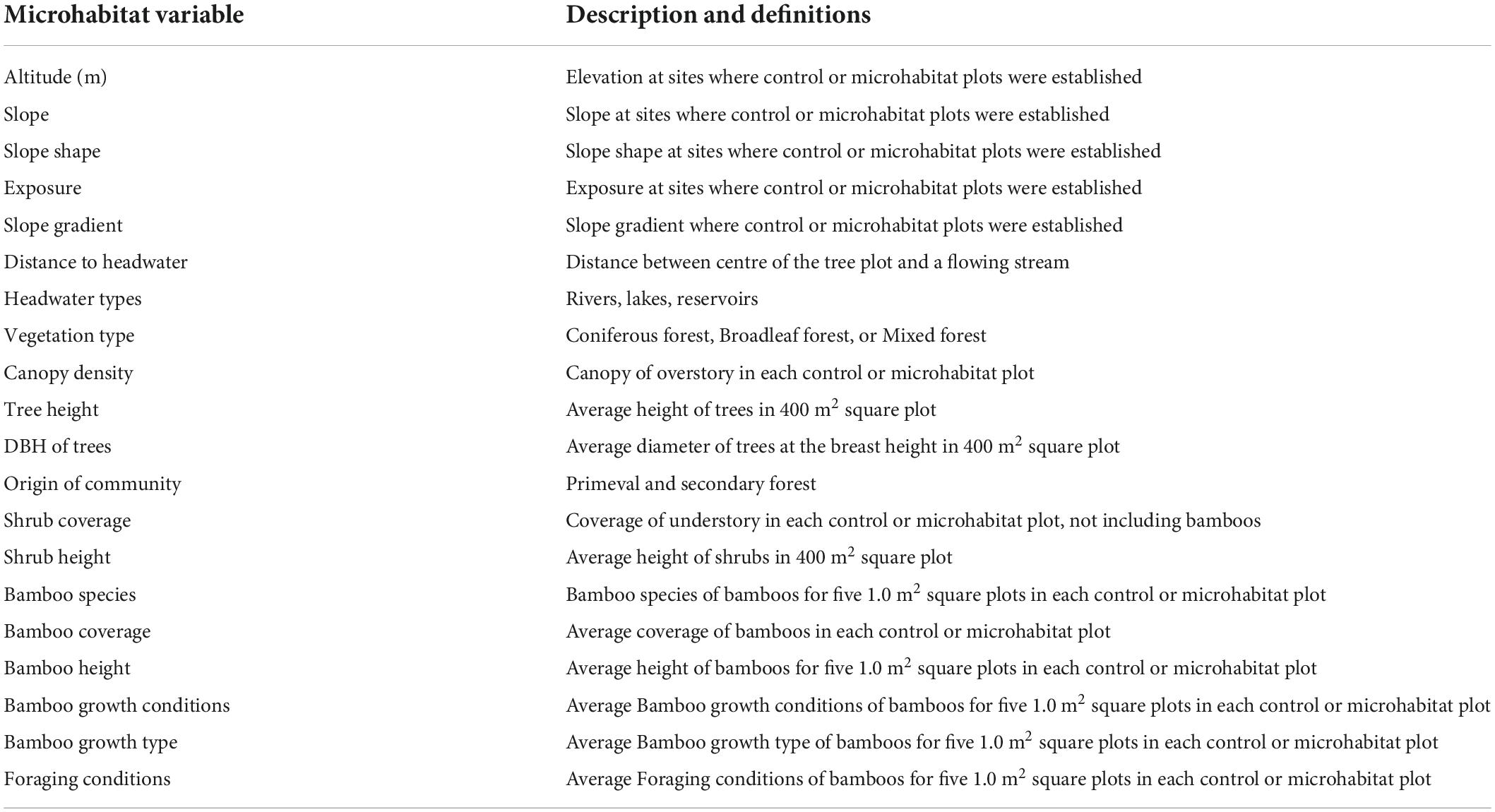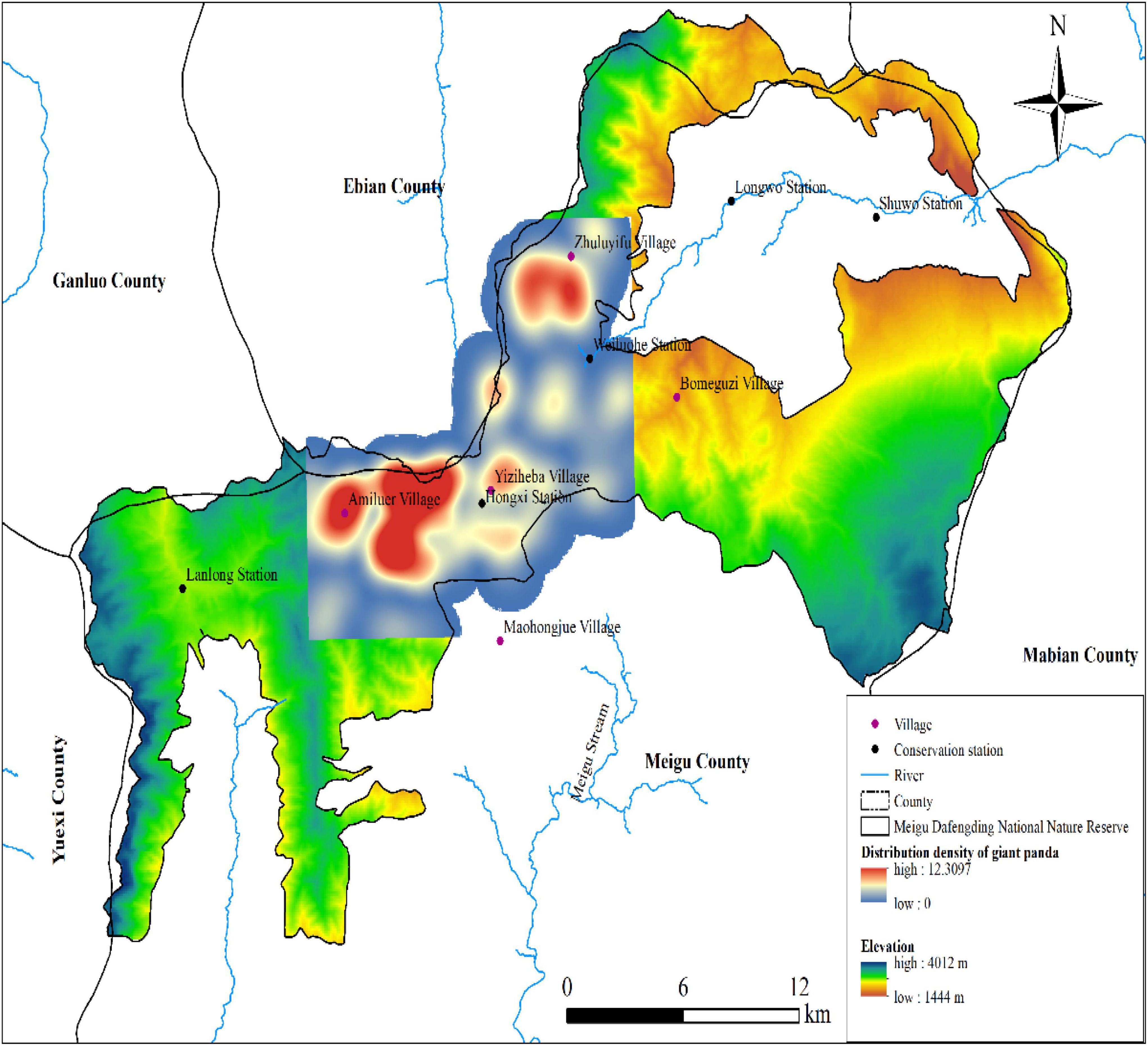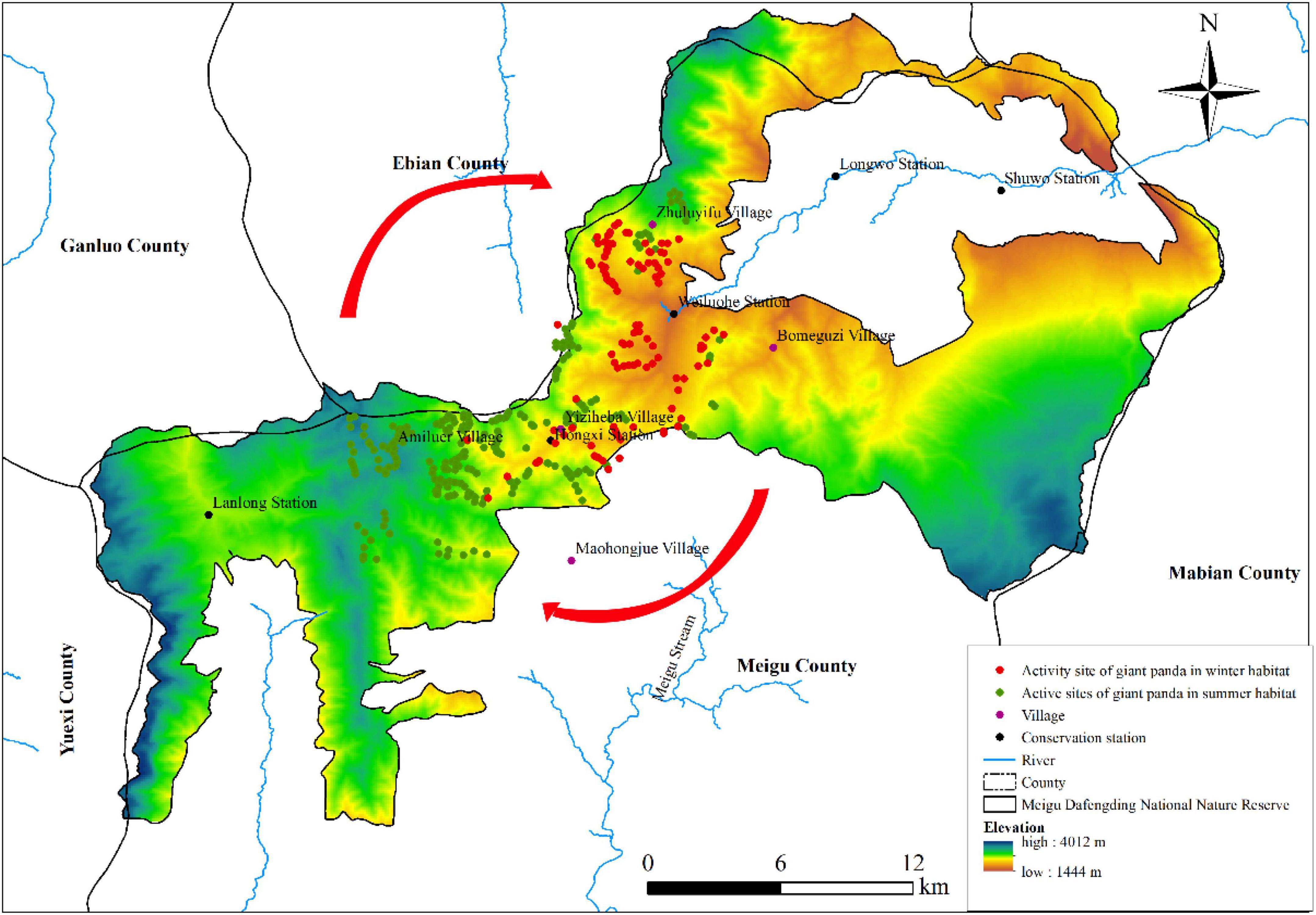- 1Key Laboratory of Southwest China Wildlife Resources Conservation (Ministry of Education), China West Normal University, Nanchong, China
- 2Liziping Giant Panda’s Ecology and Conservation Observation and Research Station of Sichuan Province, Science and Technology Department of Sichuan Province, Chengdu, China
- 3Institute of Zoology, Chinese Academy of Sciences, Beijing, China
- 4China Rural Technology Development Center, Beijing, China
- 5Sichuan Meigu Dafengding National Nature Reserve Administration, Meigu, China
The giant panda (Ailuropoda melanoleuca) is a special rare and endangered species in China and is the flagship species for global biodiversity conservation. This study used different methods including Kernel density, statistical analysis, and logistic regression analysis to investigated the spatial distribution, migration in different seasons and different distribution areas, as well as the foraging patch selection strategies of wild giant pandas in Meigu Dafengding National Nature Reserve in the Liangshan Mountains. The results demonstrated that, in the study area, giant pandas were mainly distributed in the Wahei-Yizi Yakou Habitat Corridor with an activity area of 144.93 km2, which accounted for 28.59% of the whole reserve. The core distribution area of the species was 92.07 km2 and the population density was 0.24 pcs km–2. There were two significant seasonal domains for the activities of giant pandas: the low-altitude winter habitat of Yushania maculata Yi and Yushania ailuropodina Yi bamboo species, as well as the high-altitude summer habitat of Bashania fangiana species. With seasonal changes, giant pandas migrated among different bamboo distribution regions. Giant pandas were mainly distributed in high-altitude areas that had secondary forest, tall trees with a large diameter at breast height (DBH) and bamboo forest. The spatial distribution pattern and microhabitat selection of giant pandas in Meigu Dafengding National Nature Reserve were determined. The findings of this study provide scientific implications for the local conservation and management of the habitat of wild giant pandas.
Introduction
The relationship between animals and habitat is an important component of wild animal ecology. Habitat selection is not only the dynamic selection behaviour and process of an animal in determining a more appropriate habitat but also reveals the animal’s preferences for a specific habitat. Hence, habitat selection is extremely important to the reproduction and survival of species (Johnson, 1980; Shang, 1998). Now, fragmentation and the loss of habitat are major threats to biodiversity and may lead to species extinction (Hanski, 2011; Wei et al., 2015; Almasieh et al., 2019; Kaboodvandpour et al., 2021; Mohammadi et al., 2022). Microhabitats—small patches within habitat—have a smaller range and are of significant research interest. Microhabitat research depends on data within specific patches rather than data across the whole habitat. Data in specific patches are more accurate, intuitive and authentic, and can often better reflect problems than whole-habitat data (Zhang, 2021).
Understanding the spatial and temporal habitat uses of animals is one of the core problems in ecology. The dynamic conditions of population are directly related to the space use and movement of individuals because of internal or external pressures in species (Kernohan et al., 2001). Space use refers to the environmental resource utilization mode and activity pattern of wild animals in a habitat and it influences gene exchange and survival development among population. It is not only the core aspect of animal ecology but is also the theoretical basis for biodiversity conservation (Rosenberg and McKelvey, 1999; Van Beest et al., 2010). The spatial utilization characteristics of wild animals not only determine the distribution patterns of species but can also reflect the characteristics of suitable habitats (Hull et al., 2015; Bai, 2017).
The giant panda (Ailuropoda melanoleuca) is a rare and endangered species in China and also the global symbol of biodiversity conservation in the world. Since the 20th century, China has made great efforts to protect giant pandas, including by building and improving natural reserves, “the National Forest Conservation Programs,” “the Grain to Green,” and “the wildlife and nature reserve construction project,” etc. The implementation of these ecological measures has improved the survival of wild giant panda (Wei et al., 2020). According to the 4th national survey report on giant panda in China, the habitat of the wild species is 25,800 km2, with a wild population of 1,864. The IUCN Red List of Threatened Species has adjusted giant panda from “Endangered” to “Vulnerable.” Although the species’ habitat area and population have been recovered to some extent, wild giant panda still face various threats such as global climate change, serious habitat fragmentation caused by human interference, etc. Habitat conservation is still the primary task underpinning the continuous recovery of wild giant pandas (Wei, 2015; Qing et al., 2016; Xu et al., 2017; Swaisgood et al., 2018). Therefore, studying the spatial distribution and habitat selection of giant pandas by choosing appropriate temporal and spatial scales and research methods is conducive to obtaining a deep understanding of the space-use characteristics and habitat utilization mode of the species.
Meigu Dafengding National Nature Reserve, in the Liangshan Mountains, is in the core distribution zone of giant pandas. The key habitat is the Wahei-Yizi Yakou corridor, which connects local protection zones and is key to communication between the eastern and western giant panda populations. Monitoring the distribution of giant panda in the study area and habitat conditions is of significance for protecting local species and even species and habitat conservation in Sichuan Province and around China (Zhou et al., 2013; Qing, 2016). Large- and fine-scale studies on the spatial behaviour and foraging patch selection strategies of wild giant pandas in the Liangshan Mountains were carried out using RS and GIS technologies. This study was carried out with the aims of (1) The population distribution density in the study area was calculated, (2) It reveals that giant pandas have independent areas of activity in different seasons, (3) The habitat selection behaviour and habitat utilisation mode of giant pandas in the Meigu Dafengding National Nature Reserve were determined. Our study provides a scientific implication to assist in the formulation of local conservation strategies for wild giant pandas.
Research methods
Study area
Meigu Dafengding National Nature Reserve (102°52′–103°20′E, 28°30′–28°50′N) is in the northeast region of Meigu County, Liangshan Yi Autonomous Prefecture, Sichuan Province. It belongs to the southeast edges of the Qinghai-Tibet Plateau and has an altitude range of 1356–3998 m. It covers a total area of 50655 hm2. According to the 4th national survey report on giant panda in China, there were 23 giant pandas in the Meigu Dafengding National Nature Reserve (Figure 1). The reserve has a mid-subtropical monsoon humid climate and comprises low- and high-altitude mountainous areas. It has low-latitude plateau climatic characteristics, with a small annual temperature ranger and large diurnal range. The reserve includes some complicated terrain. Regarding the vertical zonation of vegetation, there is evergreen broad-leaf forest, evergreen–defoliation–broad-leaf mixed forest, coniferous and broad-leaf mixed forest, subalpine coniferous forest and alpine shrub-meadow from low altitude to high altitude. There are seven major bamboo species in the Meigu Dafengding National Nature Reserve, including Bashania fangiana, Yushania ailuropodina Yi, Yushania dafengdingensis, Yushania brevipaniculata, Yushania maculata Yi, Yushania mabianensis, and so on (Yi, 1997).
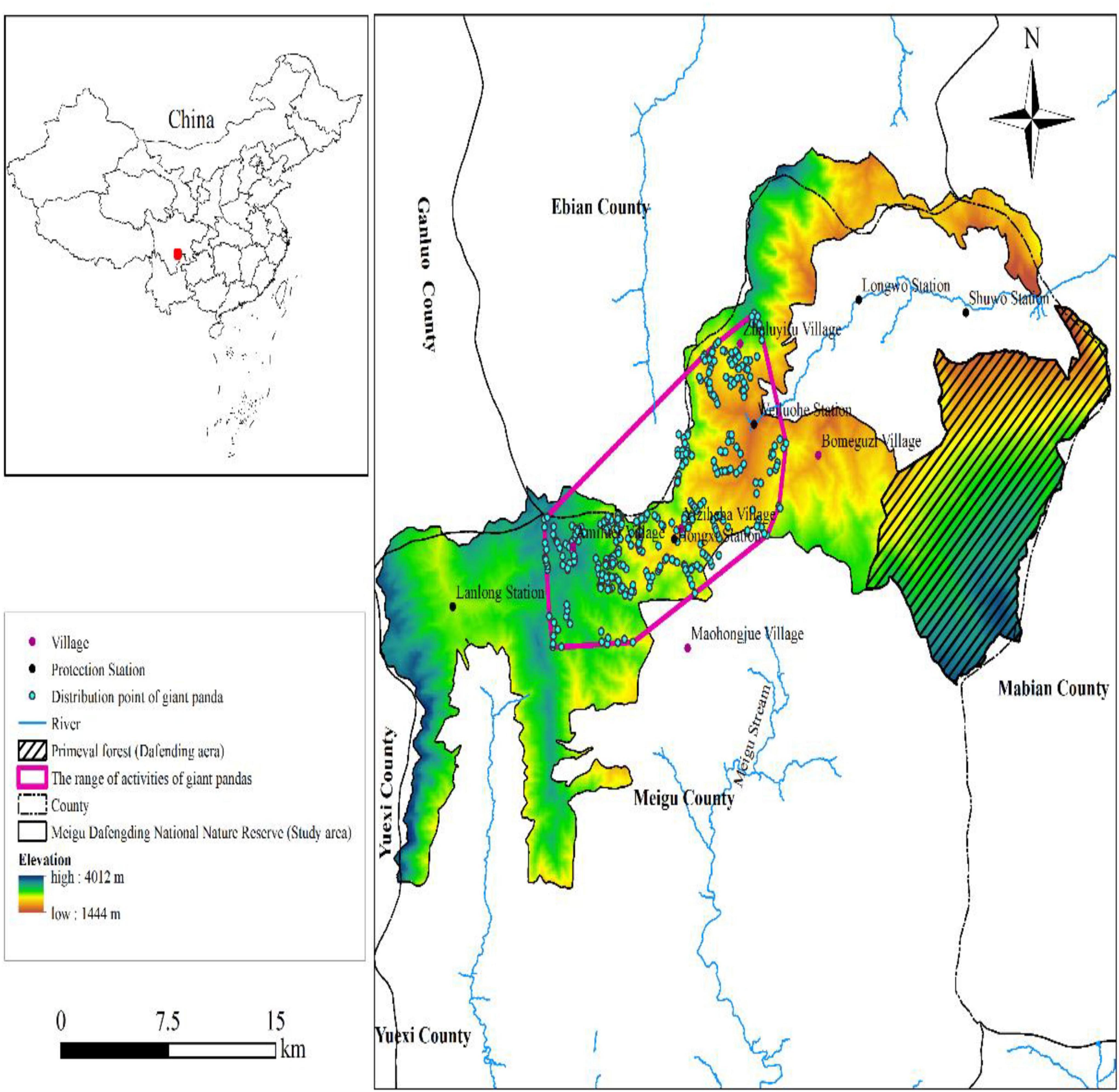
Figure 1. Distribution map of Meigu Dafengding National Nature Reserve and population distribution sites of the giant pandas.
Data collection
A total of 112 square monitoring grids (2 km2) were set uniformly in the migration corridor and core distribution zone of the study area from 2017 to 2019. In each grid, a survey line was set randomly depending on the landforms, vegetation conditions, bamboo distribution conditions, altitude and ecological habits of giant pandas. This enabled the population density of giant pandas and habitat utilisation to be investigated. In this study, individual giant pandas were monitored, while activity traces and activity sites were also collected and recorded. Once a transect point of a giant panda was discovered, a 1 m2 bamboo plot and 20 × 20 m habitat survey plot was set, centred at this point. Whereafter, at the centre of each 100 m2 quadrant within the 400-m2 square plot, an additional 1 m2 bamboo plot was also sampled. Additionally, control plots were set in regions without giant pandas activity and distribution to reflect environmental background information. The plot setting was according to the method proposed by Wei et al. (2000) and Zhang et al. (2004). In each 20 × 20 m habitat and control plot, ecological niche factors that reflected the habitat structure, upper forest layer, arboreous layer, shrub layer, bamboo layer and food resource abundance distribution and nutritional quality were collected and analysed, including the longitude, latitude, altitude, slope, canopy density, coverage, bamboo density, etc. (Table 1).
Data processing
Kernel density estimation (KDE) is based on the possibility that an event may occur at any position within a certain spatial range. However, the probability at different geographic positions is different. If an event occurs many times in a region, this event is considered as having a high frequency of occurrence in this region. Otherwise, it has a low frequency of occurrence. KDE is a probability model method and the non-parametric home domain estimation based on spatial distribution can distinguish the utilization intensity of animals in different spaces (Powell, 2000; Kernohan et al., 2001; Laver and Kelly, 2008). In this study, KDE was chosen to estimate the home domain distribution of giant pandas in the study area. Each activity site was entered into the ArcGIS (10.5) software to analyse the activity range of the species, calculate the distribution density and home domain differentiation with seasons, and determine driving factors that influenced the population migration.
A total of 1,280 monitoring plots were investigated, including 414 plots related to habitat selection by giant pandas and 866 control plots. Ecological niche factors which include longitude, latitude, altitude, slope, canopy density, coverage, bamboo density, etc., were collected and tested in each habitat and control plots. These habitat selection and ecological niche factor data were input into Excel for the relevant conversions. Following conversion, data were input into SPSS13.0 for normality testing via the one-sample K-S test. Data that conformed to a normal distribution was tested through one-way analysis of variance (ANOVA) and data that did not conform to a normal distribution was tested by the Mann–Whitney U test. Additionally, the utilization modes of habitat selection by giant pandas were determined through correlation analysis and logistic regression analysis (LRA). Among, Logistic regression analysis is a common method to analyse the complicated correlations between binary response variables (e.g., life or death, being or not being) and independent variables. To ensure the independence of variables in the logistic regression analysis, correlation analysis between any two variables is carried out. If the correlation coefficient between two variables is higher than 0.5, it is believed that these two variables contain roughly the same information; in this case, only the variable with more important biological significance is retained in the follow-up logistic regression analysis. The Pearson correlation analysis was chosen for data with normal distribution and the Spearman correlation analysis for data with abnormal distribution.
Results
A total of 112 survey routes were completed from 2017 to 2019, covering a total length of 251.76 km. In the survey, 274 trajectory sites of giant pandas were discovered in 82 survey grids. Specifically, there were 169 transects sites in the 48 grids in the corridor region, accounting for 43% of all survey grids in the corridor. There were also 10 transect sites in 10 grids outside of the corridor. The transect density of giant pandas was highest in the grid of forests on the Yizi River Dike. In this forest, feces and foraging traces were the two major types of trace observed in grids, including 176 feces, 85 foraging traces, five foot traces, five sleeping traces, two hair traces, and one cave trace.
Distribution range and density analysis
According to the ArcGIS analysis, the giant panda density was relatively concentrated in the Meigu Dafengding National Nature Reserve. In the corridor region, there were two zones with frequent giant panda activity: from the Yizi Yakou at the Meigu-Ebian border to the Dueryida Area and Zhuluyifu Area. In the Maohongjue Forest area, a new activity corridor of giant panda was discovered, in which 12 grids were set. Among these, 18 transects of giant pandas were discovered in 10 grids, accounting for 83% of all grids in the zone. In this region, no giant panda activity had been discovered since 2008, indicating that the local environment had been effectively protected and had become another habitat for giant panda.
In the Meigu Dafengding National Nature Reserve, the giant panda population was mainly distributed at the Hongxi Conservation Station, Weiheluo Conservation Station and Wahei-Yizi Yakou Habitat Corridor. These areas accommodated more than 90% of giant panda individuals. There was almost no giant panda distribution and activity in the Lanlong Conservation Station, Longwo Conservation Station, Shuwo Conservation Station, and Bingtu Conservation Station. The total activity area was 144.93 km2, which accounted for 28.59% of the whole reserve area. Most of these areas are in the core area of the reserve, which is also within the suitable habitat and potentially suitable habitat scope for giant panda (Figure 1). For the Dafengding area, which has the largest area in the reserve, there has been no distribution of giant panda since the third national survey in 2002.
Additionally, the population density and core distribution area of giant pandas in the Meigu Dafengding National Nature Reserve were analysed. The results showed that the kernel domain area of Conservation Station was 92.07 km2, which was concentrated in the Wahei-Yizi Yakou Corridor. The highest distribution density was in the Hongxi Conservation Station, followed by that near the Weiheluo Conservation Station. The distribution density of giant pandas in the whole reserve was only 0.24 pcs km–2, which was far lower than the capacity threshold (Figure 2).
Seasonal migration
According to the analysis of the activity regions and distribution range of giant pandas in different seasons, two significant seasonal home domains were identified in the reserve. For most of the year (spring, autumn, and winter), the activity range was concentrated at the low-altitude Hongxi Conservation Station and near Wahei-Yiziy Yakou (winter habitat). In summer, after the shooting of B. fangiana in the high-altitude regions, giant pandas migrated vertically to altitudes of over 2700 m. In autumn, the population migrated back to the low-altitude region for foraging due to the decreasing temperature at high altitudes and the lignification of B. fangiana. The cycle then began again (Figure 3).
Microhabitat selection
A total of 1280 monitoring plots were investigated, including 414 plots of habitat selection and 866 control plots. The one-sample K-S test was carried out for 20 ecological factors in the habitat selection plots and control plots. The results showed that six variables—including the altitude, canopy density, tree height, DBH of trees, shrub coverage, and bamboo height—were normally distributed, while the other 14 variables, including slope, were not. The plot type was used as the control variable for ANOVA. In normally distributed variables, there were significant differences in the altitude, tree height and DBH of trees (p < 0.05) but no significant differences in the canopy density, shrub height, and bamboo height (p > 0.05). In the control plots and habitat selection plots, the Mann–Whitney U test disclosed significant differences for eight variables, including the headwater type, vegetation type, origin of community, shrub coverage, bamboo species, bamboo coverage, bamboo growth type, and foraging conditions (p < 0.05). However, there was no significant difference in the slope, slope shape, slope gradient, exposure, distance to headwater or bamboo growth conditions (p > 0.05; Table 2).
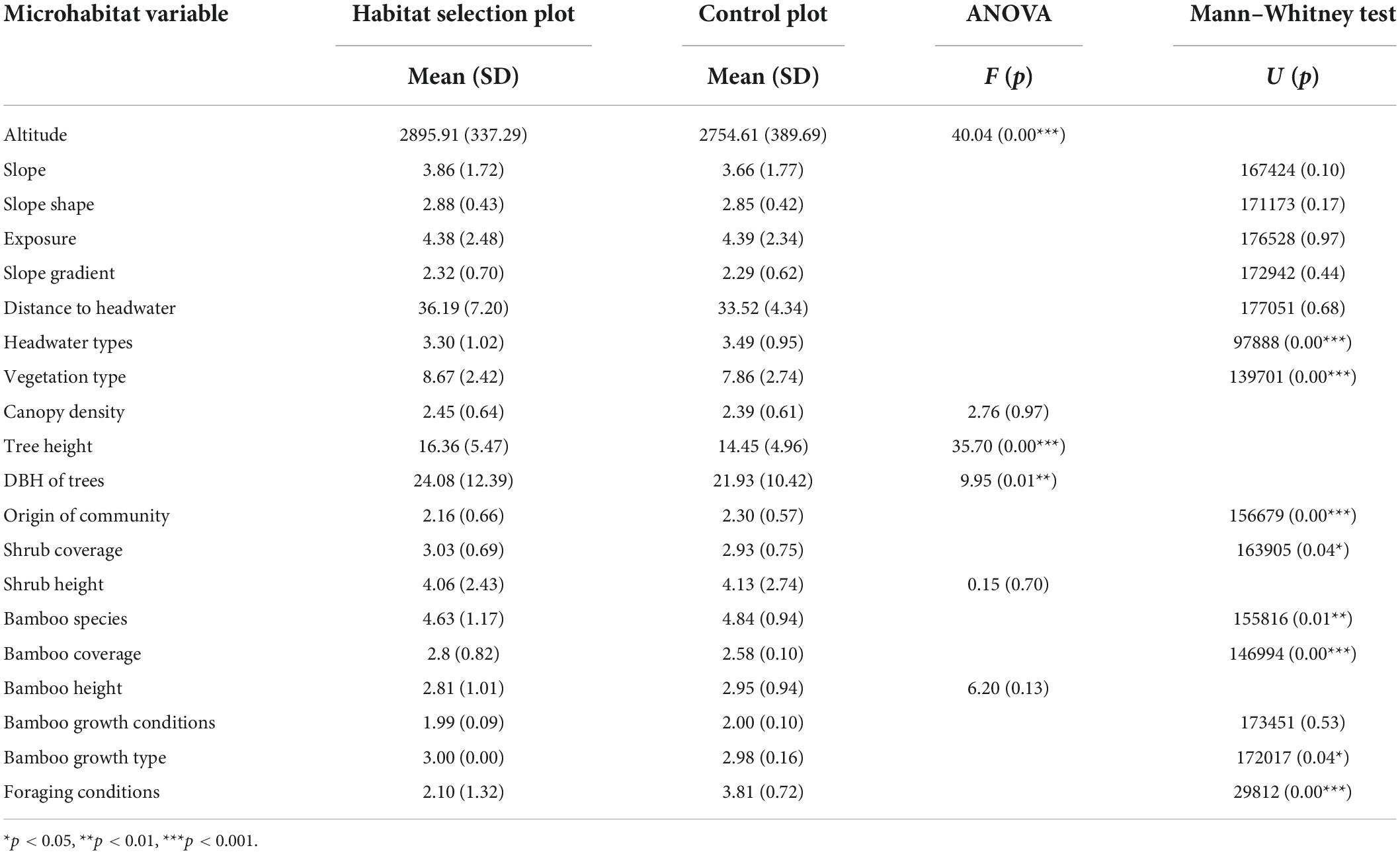
Table 2. Comparison of variables in habitat selection plots and control plots in the study area by analysis of variance (ANOVA) and Mann–Whitney U tests.
According to the analysis results, the correlation coefficients of two groups of variables exceeded 0.5 (Table 3). For tree height and DBH of trees, larger DBH is associated with a taller tree, hence, DBH of trees—which has more biological significance—was retained in the follow-up regression equation. Similarly, for the following variable groups: bamboo coverage and shrub coverage, it was the DBH of trees and bamboo coverage that were retained in the regression equation.
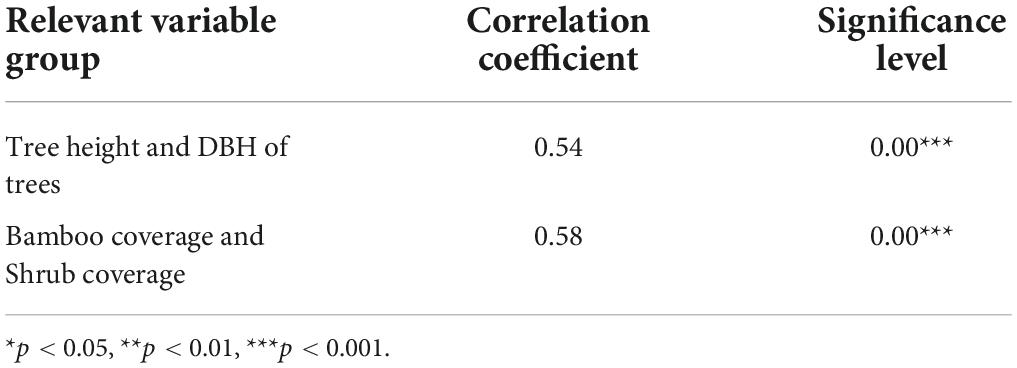
Table 3. Variable groups with correlation coefficients exceeding 0.5 and corresponding significance level.
The logistic regression analysis results are shown in Table 4. Significant differences (p < 0.05) were found for the distance to headwater, DBH of trees, Slope shape, vegetation type, Canopy density, Bamboo species, bamboo height, bamboo coverage, and Foraging conditions. At the same time, the absolute value of the corresponding regression coefficient is relatively high, because the absolute value of the regression coefficient represents the contribution of the corresponding variable to the regression equation. Therefore, the ecological factors that determine habitat selection and habitat utilization patterns of giant pandas are habitat factors such as trees, vegetation, and bamboo forest resources, which are roughly similar to the results obtained by one-way ANOVA and Mann–Whitney test above.
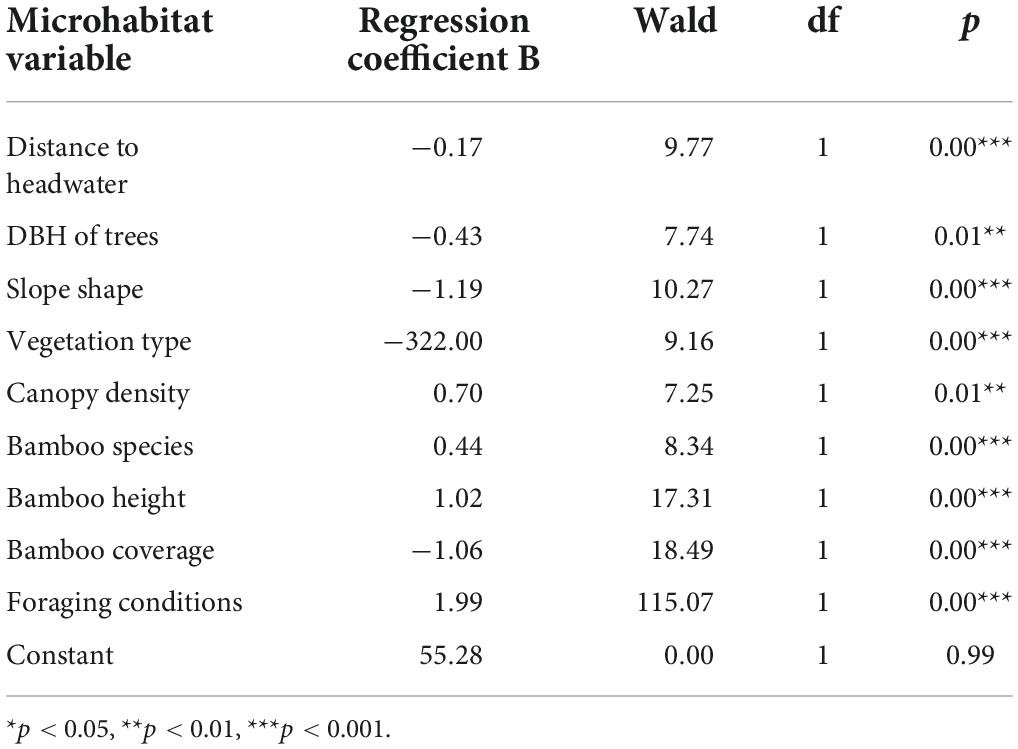
Table 4. Logistic regression analysis between giant panda habitat selection plots and control plots.
Based on the means of variables in different groups, some characteristics of the habitat selection and habitat use mode of giant pandas in Meigu Dafengding National Nature Reserve were identified. The giant panda was mainly distributed in high-altitude (2895.91 ± 337.92 m) secondary forests of mixed broadleaf–conifer forest or temperate coniferous forest near water ponds, where there were tall trees with large DBH, high shrub coverage and bamboo forest. These areas contained high coverage and scattered distributions of Y. maculata Yi, Y. ailuropodina Yi, and B. fangiana. the giant panda prefers bamboo shoots (Figure 4).
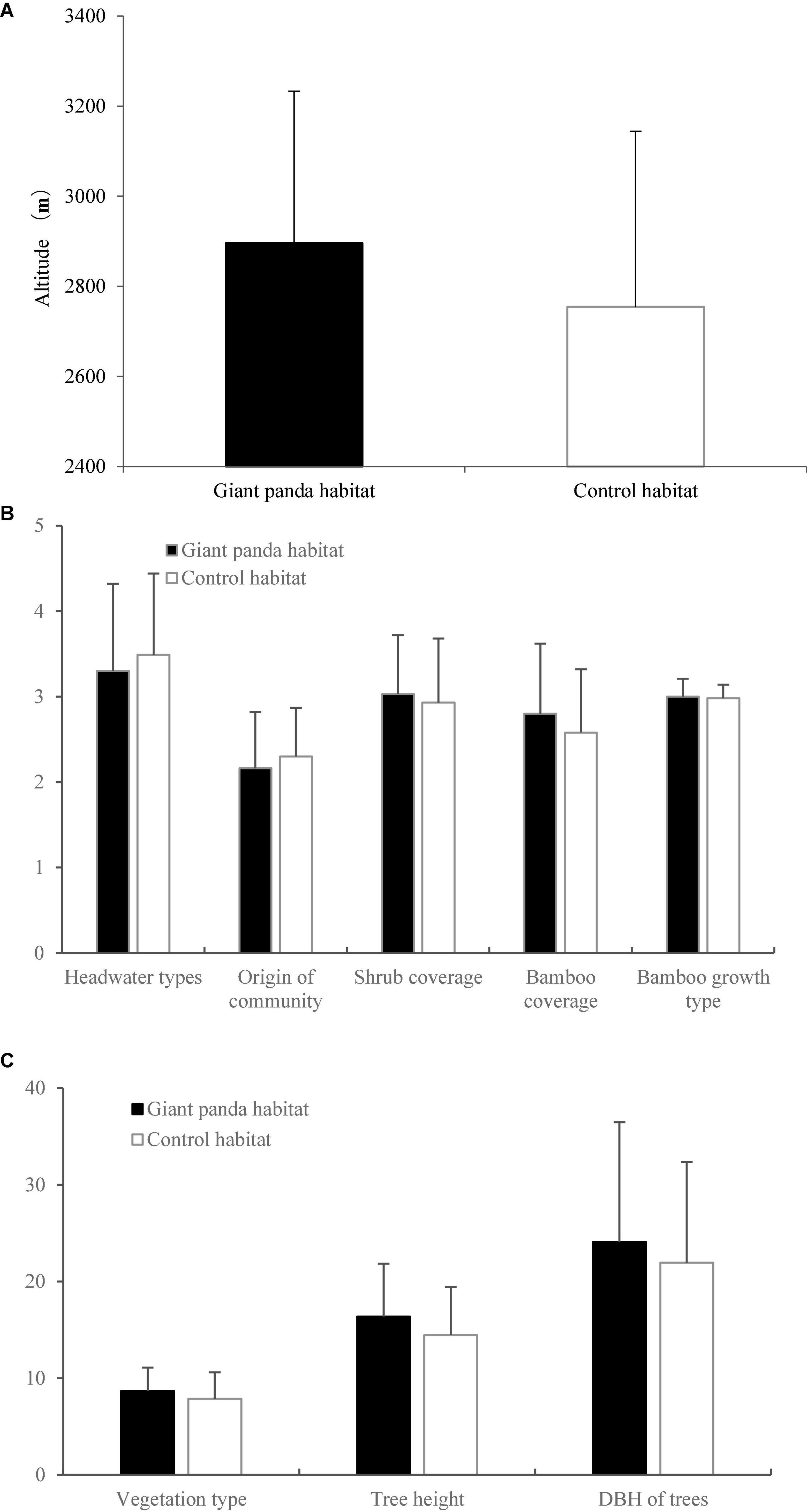
Figure 4. Selection and utilisation of different habitat factors by giant pandas. (A) Selection and utilization of giant panda habitat and control habitat at altitude. (B) Selection and utilization of giant panda habitat and control habitat at headwater types, origin of community, shrub coverage, bamboo coverage and bamboo growth type. (C) Election and utilization of giant panda habitat and control habitat at vegetation type, tree height and DBH of trees.
Discussion
To understand the population dynamics and microhabitat selection of giant pandas in the Liangshan Mountains, regular monitoring of wild populations in the Meigu Dafengding National Nature Reserve was implemented for a year. First, the population dynamics and distribution patterns were analysed using ArcGIS. The highest distribution density of giant pandas was in Hongxi Conservation Station, followed by places near Weiheluo Conservation Station. A habitat is an essential place for the survival and daily activities of giant pandas. The study demonstrated that giant panda prefers to be close to the primitive forest of the central area, which has high altitude, great gradient, advantageous conditions for raising young, foraging, hiding from enemies and keeping away from disturbances (Hong et al., 2012, 2015). When studying the landscape level of giant panda habitat, Zhang et al. (2011) found that—except for the essential factor of bamboo—giant pandas prefer to live in primitive forests without logging activities or human disturbance. People usually cut down trees with high DBH at locations with low slope gradients and close to highways. This may influence the migration of giant pandas and their utilisation of caves. However, the results of the present study demonstrated that—as the largest primitive forest in the reserve—the Dafengding area has extensive distributions of bamboo in the lower layer of the continuous primitive forest as well as high bamboo coverage and good growing conditions, but no activity trajectories of giant pandas were identified. This could be because human activity and disturbance have severely restricted the distribution of giant pandas in the Dafengding area (Wei et al., 1989, 2018; Gui et al., 2012; Zhao et al., 2017). Grazing has become an important human disturbance in the reserve (Filazzola et al., 2020). In particular, overgrazing near the Dafengding area and the large livestock population (e.g., scattered cultivation of Poëphagus grunniens, cattle and horses) in the habitat of giant pandas pose significant threats to the survival of Giant panda. Some studies have demonstrated that the giant panda avoids grazing, to some extent (Wang et al., 2015). Additionally, large-scale livestock grazing destroys the growth and regrowth of bamboo, thereby damaging suitable giant pandas habitats; this may force giant pandas to use other habitats (Wang et al., 2015; Li et al., 2017; Zhang et al., 2017).
Animal migration is an important field in the ecological study of animal behaviour. Exploring the causes, mechanisms and modes of species migration can facilitate an understanding of the influence of migration behaviour on the ecology and evolution of individuals, populations, and communities (Nathan et al., 2008). The present study identified a pronounced seasonal migration of local giant pandas. The species used locations above 2700 m as their habitat in summer and migrated to low-altitude regions in winter. This migration phenomenon also occurs in the Meigu Natural Reserve and Foping Natural Reserve in the Qinling Mountains. Other studies have demonstrated that the spatial behaviour of giant pandas in the Qinling Mountains is mainly influenced by food resources. Bamboo is the sole food source of giant pandas, with its nutritional quality, distribution and secondary metabolites (PSM) in bamboo directly influencing the altitudinal preference and diet selection of giant pandas (Zhang et al., 2014; Nie et al., 2015; Wei, 2015; Wang et al., 2020). This may be because the seasonal migration of giant pandas accompanies phenological changes in resources. To acquire bamboo organs with high nutrition value, the giant pandas may migrate among the distribution regions of different bamboo species with seasonal changes (Nie et al., 2015; Wei et al., 2015). Similar to the migration of giant pandas in the Qinling Mountains, the migration of giant pandas in the Meigu National Natural Reserve may also be related to phenological changes in bamboo growth. To obtain different bamboo species and bamboo organs with higher nutritional quality in different seasons, giant panda may migrate to the high-altitude regions of shooting B. fangiana. Then, before autumn, G. panda may migrate to low-altitude regions again due to the decreasing temperatures at high altitudes and the lignification of B. fangiana shoots. Another cycle begins the next year.
Studies on habitat selection are of significance in the evaluation of habitat quality, predicting suitable habitats for species, exploring causes of species endangerment and enabling the formulation of reasonable protection strategies. The present study found that the giant panda was mainly distributed in high-altitude areas with secondary forests, tall trees with large DBH and bamboo forest. This was in contrast to a previous study—based on four mountains in Sichuan Province—which determined that giant pandas preferred primitive forest with tall trees that could provide them suitable habitat (Zhang et al., 2011). This difference may have been due to the good recovery of secondary forest in the study area and the tall trees, which provided suitable habitat for giant pandas. The giant panda has a highly specialised eating habit: bamboo is its major food source. By analysing the microhabitat landscape and nutrition in Foping Natural Reserve, Wei et al. (2017) concluded that giant pandas may choose habitats with higher nutritional quality. This aligned with the research conclusion of the present study: the giant panda chooses bamboo with higher nutritional value.
Conclusion
In summary, the Meigu National Natural Reserve mainly protects wild animals, as represented by giant pandas, and the forest ecosystem. There are good natural forest conditions as well as a high distribution density and extensive activity range of wild giant panda. Additionally, there are seasonal changes in the population distribution. The protection effect in the study area and even throughout the Liangshan Mountains was significant. According to theories and practices, it is crucial to ensure the quality of giant pandas habitat and prevent habitat fragmentation. The population of giant panda can increase slowly if the habitat is protected well and there is a sufficient food supply (Wei et al., 1989).
Management implications
There are still threats that cause fragmentation of habitat in the Meigu National Natural Reserve. In this Reserve, giant pandas are an isolated and small group, comprising one of five small groups in the Liangshan Mountains. The effective population size is small and there is an imbalanced gender distribution (male:female = 17:5). Some reserves had decreasing populations since the fourth national survey. There are some administrative villages in the Reserve that have high pedestrian volume and large villager populations, resulting in strong human disturbance. In particular, there is significant grazing and herb collection. The habitat fragmentation is pronounced and habitat quality is poor. Based on the results of this study, the following suggestions are proposed:
(1) Increase the migration rate among different populations. As there is no giant panda in the Dafengding area, an ecological corridor could be built to connect with the Mabian Dafengding Natural Reserve to increase migration and diffusion between the two regions.
(2) Increase the environmental capacity by recovering habitat, increasing the connectivity between habitats and expanding the core habitats of giant pandas.
(3) Climate change has impacted the periodic blooming of bamboos, with a drift toward high-latitude and high-altitude regions; accordingly, the giant panda cannot acquire enough food sources. Bamboo species could be planted artificially to ameliorate this effect.
(4) Decrease major human disturbances in the reserve. The population and scale of livestock should be controlled strictly to relieve the influence of grazing on the population and habitat of giant pandas. An increase in the ecological awareness of surrounding villagers is needed to minimise human disturbance of the Reserve’s ecosystem and biodiversity. Additionally, a change in the income source structure of villagers is needed to decrease excessive dependence on natural resources in the reserve, such as through ecological compensation.
Data availability statement
The original contributions presented in this study are included in the article/supplementary material, further inquiries can be directed to the corresponding author.
Ethics statement
Ethical review and approval was not required for the animal study because this study involved only field investigation and had no effect on animals.
Author contributions
HH and YC designed this project. YG and MC conducted field investigation. LQ, XW, HZ, and XZ conducted the data query and statistics. WW and YC wrote the manuscript, with contributions from HH. All authors have read and agreed to the published version of the manuscript.
Funding
This study was supported by the National Natural Science Foundation of China (32070524 and 31801992), Science and Technology Department of Sichuan Province (2022JDJQ0060 and 2022JDR0033), and the Second Qinghai-Tibet Plateau Comprehensive Scientific Survey (2019QZKK05010502).
Conflict of interest
The authors declare that the research was conducted in the absence of any commercial or financial relationships that could be construed as a potential conflict of interest.
Publisher’s note
All claims expressed in this article are solely those of the authors and do not necessarily represent those of their affiliated organizations, or those of the publisher, the editors and the reviewers. Any product that may be evaluated in this article, or claim that may be made by its manufacturer, is not guaranteed or endorsed by the publisher.
References
Almasieh, K., Rouhi, H., and Kaboodvandpour, S. (2019). Habitat suitability and connectivity for the brown bear (Ursus arctos) along the Iran-Iraq border. Eur. J. Wildlife Res. 65:57. doi: 10.1007/s10344-019-1295-1
Bai, W. (2017). The Dynamics of Space Utilization and Habitat Selection of Giant Pandas (Ailuropoda melanoleuca) in Wolong Nature Reserve. Doctor thesis, China: Inner Mongolia Agricultural University.
Filazzola, A., Brown, C., Dettlaff, M. A., Batbaatar, A., Grenke, J., Bao, T., et al. (2020). The effects of livestock grazing on biodiversity are multi-trophic: a meta-analysis. Ecol. Lett. 23, 1298–1309. doi: 10.1111/ele.13527
Gui, Z., Song, G., and Chen, Y. (2012). Simulation study on giant panda population dynamics model with due consideration for deforestation. Proc. Environ. Sci. 13, 2091–2097. doi: 10.1016/j.proenv.2012.01.199
Hanski, I. (2011). Habitat loss, the dynamics of biodiversity, and a perspective on conservation. Ambio 40, 248–255. doi: 10.1007/s13280-011-0147-3
Hong, M., Wang, J., Yang, X., Gu, X., and Zhang, Z. (2012). Comparison of structures of microhabitat by giant pandas in old-growth and secondary forests. J. Chin. West Norm. Univ. Nat. Sci. Ed. 33, 356–361.
Hong, M., Yuan, S., Yang, Z., Yang, X., Gu, X., Huang, F., et al. (2015). Comparison of microhabitat selection and trace abundance of giant pandas between primary and secondary forests in liziping nature reserve, China: effects of selective logging. Mamm. Bio 80, 373–379. doi: 10.1016/j.mambio.2015.05.003
Hull, V., Zhang, J., Zhou, S., Huang, J., Li, R., Liu, D., et al. (2015). Space use by endangered giant pandas. J. Mammal. 96, 230–236. doi: 10.1093/jmammal/gyu031
Johnson, D. H. (1980). The comparison of usage and availability measurements for evaluating resource preference. Ecology 61, 65–71. doi: 10.2307/1937156
Kaboodvandpour, S., Almasieh, K., and Zamani, N. (2021). Habitat suitability and connectivity implications for the conservation of the Persian leopard along the Iran–Iraq border. Ecol. Evol. 11, 13464–13474. doi: 10.1002/ece3.8069
Kernohan, B. J., Gitzen, R. A., and Millspaugh, J. J. (2001). “Analysis of animal space use and movements,” in Radio Tracking and Animal Populations, eds J. J. Millspaugh and J. M. Marzluff (San Diego, CA: Academic Press). doi: 10.1016/B978-012497781-5/50006-2
Laver, P. N., and Kelly, M. J. (2008). A critical review of home range studies. J. Wildlife Manage 72, 290–298. doi: 10.2193/2005-589
Li, B. V., Pimm, S. L., Li, S., Zhao, L., and Luo, C. J. B. C. (2017). Free-ranging livestock threaten the long-term survival of giant pandas. Biol. Conserv. 216, 18–25. doi: 10.1016/j.biocon.2017.09.019
Mohammadi, A., Almasieh, K., Nayeri, D., Adibi, M. A., and Wan, H. Y. (2022). Comparison of habitat suitability and connectivity modelling for three carnivores of conservation concern in an Iranian montane landscape. Landscape Ecol. 37, 411–430.
Nathan, R., Getz, W. M., Revilla, E., Holyoak, M., Kadmon, R., Saltz, D., et al. (2008). A movement ecology paradigm for unifying organismal movement research. PANS 105, 19052–19059. doi: 10.1073/pnas.0800375105
Nie, Y., Zhang, Z., Raubenheimer, D., Elser, J. J., Wei, W., and Wei, F. (2015). Obligate herbivory in an ancestrally carnivorous lineage: the giant panda and bamboo from the perspective of nutritional geometry. Funct. Ecol. 29, 26–34. doi: 10.1111/1365-2435.12302
Powell, R. A. (2000). Animal home ranges and territories and home range estimators. Res. Tech. Animal Ecol. Controversies Consequences 442, 65–110.
Qing, J. (2016). Study on the Habitat Fragmentation Anddesigning Corridors of Giant Panda in Sichuan Province. Master thesis, China: China West Normal University.
Qing, J., Yang, Z., He, K., Zhang, Z., Gu, X., Yang, X., et al. (2016). The minimum area requirements (MAR) for giant panda: an empirical study. Sci. Rep. 6:37715. doi: 10.1038/srep37715
Rosenberg, D. K., and McKelvey, K. S. (1999). Estimation of habitat selection for central-place foraging animals. J. Wildlife Manage 63, 1028–1038. doi: 10.2307/3802818
Swaisgood, R. R., Wang, D., and Wei, F. (2018). Panda downlisted but not out of the woods. Conserv. Lett. 11:e12355. doi: 10.1111/conl.12355
Van Beest, F. M., Loe, L. E., Mysterud, A., and Milner, J. M. (2010). Comparative space use and habitat selection of moose around feeding stations. J. Wildlife Manage 74, 219–227. doi: 10.2193/2009-109
Wang, F., McShea, W. J., Wang, D., and Li, S. (2015). Shared resources between giant panda and sympatric wild and domestic mammals. Biol. Conserv. 186, 319–325. doi: 10.1016/j.biocon.2015.03.032
Wang, L., Yuan, S., Nie, Y., Zhao, J., Cao, X., Dai, Y., et al. (2020). Dietary flavonoids and the altitudinal preference of wild giant pandas in foping national nature reserve. China. Glob. Ecol. Conserv. 22:e00981. doi: 10.1016/j.gecco.2020.e00981
Wei, F., Feng, Z., Wang, Z., and Hu, J. (2000). Habitat use and separation between the giant panda and the red panda. J. Mamm. 81, 448–455. doi: 10.1093/jmammal/81.2.448
Wei, F., Hu, J., Xu, G., Jiang, M., Deng, Q., and Zhong, Z. (1989). A study on the life table of wild giant pandas. Acta Theriol. Sinica 9, 81–86.
Wei, F., Swaisgood, R., Hu, Y., Nie, Y., Yan, L., Zhang, Z., et al. (2015). Progress in the ecology and conservation of giant pandas. Conserv. Biol. 29, 1497–1507. doi: 10.1111/cobi.12582
Wei, W. (2015). Spatial Movement Behavior and Foraging Patch Selection Strategies of Wild Giant Pandas (Ailuropoda melanoleuca) in Qinling Mountains. China: University of Chinese Academy of Sciences.
Wei, W., Huang, Y.-Y., Hong, Z., Shi-Bin, Y., Zhi-Xin, Z., Yong-Gang, N., et al. (2017). Microhabitat separation between giant panda and golden takin in the Qinling Mountains and implications for conservation. North-West J. Zool. 13, 109–117.
Wei, W., Swaisgood, R. R., Dai, Q., Yang, Z., Yuan, S., Owen, M. A., et al. (2018). Giant panda distributional and habitat-use shifts in a changing landscape. Conserv. Lett. 11:e12575. doi: 10.1111/conl.12575
Wei, W., Swaisgood, R. R., Pilfold, N. W., Owen, M. A., Dai, Q., Wei, F., et al. (2020). Assessing the effectiveness of China’s panda protection system. Curr. Biol. 30, 1280–1286.e2. doi: 10.1016/j.cub.2020.01.062
Xu, W., Viña, A., Kong, L., Pimm, S. L., Zhang, J., Yang, W., et al. (2017). Reassessing the conservation status of the giant panda using remote sensing. Nat. Ecol. Evol. 1, 1635–1638. doi: 10.1038/s41559-017-0317-1
Zhang, B. (2021). Multi-level, Multi-scale Habitat Selection of the Critically Endangered Mangshan Pit Viper (Protobothro;ps mangshanensis), a Species Endemic to China. Doctor thesis, China: Central South University of Forestry and Technology.
Zhang, J., Vanessa, H., Ouyang, Z., Li, R., and Thomas, C. (2017). Divergent responses of sympatric species to livestock encroachment at fine spatiotemporal scales - sciencedirect. Biol. Conserv. 209, 119–129. doi: 10.1016/j.biocon.2017.02.014
Zhang, Z., Sheppard, J. K., Swaisgood, R. R., Wang, G., Nie, Y., Wei, W., et al. (2014). Ecological scale and seasonal heterogeneity in the spatial behaviors of giant pandas. Integr. Zool. 9, 46–60. doi: 10.1111/1749-4877.12030
Zhang, Z., Swaisgood, R. R., Zhang, S., Nordstrom, L. A., Wang, H., Gu, X., et al. (2011). Old-growth forest is what giant pandas really need. Biol. Lett. 7, 403–406. doi: 10.1098/rsbl.2010.1081
Zhang, Z., Wei, F., Li, M., Zhang, B., Liu, X., and Hu, J. (2004). Microhabitat separation during winter among sympatric giant pandas, red pandas, and tufted deer: the effects of diet, body size, and energy metabolism. Can. J. Zool. 82, 1451–1458. doi: 10.1139/z04-129
Zhao, C., Yue, B., Ran, J., Moermond, T., Hou, N., Yang, X., et al. (2017). Relationship between human disturbance and Endangered giant panda Ailuropoda melanoleuca habitat use in the Daxiangling Mountains. Oryx 51, 146–152. doi: 10.1017/S0030605315000800
Keywords: Ailuropoda melanoleuca, spatial distribution, microhabitat selection, management implication, Meigu Dafengding National Nature Reserve
Citation: Chen Y, Wang X, Zheng X, Gong Y, Chen M, Qiu L, Zhou H, Wei W and Han H (2022) Space use and microhabitat selection of wild giant pandas in Meigu Dafengding National Nature Reserve, China. Front. Ecol. Evol. 10:1000841. doi: 10.3389/fevo.2022.1000841
Received: 22 July 2022; Accepted: 26 August 2022;
Published: 13 September 2022.
Edited by:
Anouschka R. Hof, Wageningen University and Research, NetherlandsReviewed by:
Kamran Almasieh, Khuzestan University of Agricultural Sciences and Natural Resources, IranArjun Thapa, Tribhuvan University, Nepal
Copyright © 2022 Chen, Wang, Zheng, Gong, Chen, Qiu, Zhou, Wei and Han. This is an open-access article distributed under the terms of the Creative Commons Attribution License (CC BY). The use, distribution or reproduction in other forums is permitted, provided the original author(s) and the copyright owner(s) are credited and that the original publication in this journal is cited, in accordance with accepted academic practice. No use, distribution or reproduction is permitted which does not comply with these terms.
*Correspondence: Han Han, aGFuZ2hhbmc3MzlAaG90bWFpbC5jb20=
 Yuxiang Chen1,2
Yuxiang Chen1,2 Wei Wei
Wei Wei Han Han
Han Han